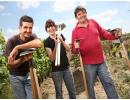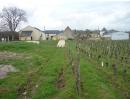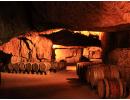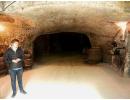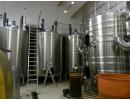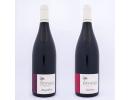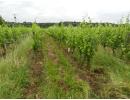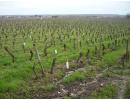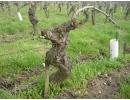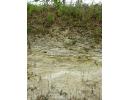Domaine de la Chevalerie
Domaine de la Chevalerie “Galichets” 2011 - Bourgueil
This is the main wine of the domaine being the biggest plot of 10 ha as a single vineyard. The 45 years old Cabernet Franc vines produce a low yield of 35 hl/ha. The grapes are destemmed and fermentations are done in stainless steel vats for 3 to 4 weeks at 27°C. The wine is aged for about 8 months in 400 to 500 litres demi-muid barrels that are 4 to 8 years old to reduce the oak effect on the wine.
PVins notes: This is an easy drinking Cabernet Franc with smooth tannins and great varietal aromatic characteristics of redberries and spices with hints of licorice and earthiness on the finish. The cellaring potential is 5 to 7 years.
Press: Guide Hachette des Vins 2014 - Excellent
This domaine of reference was not far from renewing a "Coup de Coeur" with its cuvée "Galichets", made of old Cabernet Franc nestled in gravel left behind by the Loire and hand harvested in small crates. Intense ruby coloured, a prelude to an aromatic expression of remarkable freshness fulfilled around the cassis. Velvety and fleshy, caressing the mouth.
Domaine de la Chevalerie “Busardières” - Bourgueil
The wine is one of the 3 premium Cabernet Franc wines produced from 55 years old vines. The 2.50 ha are set on the ideal terroir of clayey-limestone and flint on “tuffeau” facing southwest. The yield is very low at 20-25 hl/ha, similar to some great reds from Burgundy, the Rhône Valley and Bordeaux. The grapes are destemmed and fermentations are done in stainless steel vats for 3 to 4 weeks. The wine is aged from 9 to 12 months in oak barrels that vary in size from 225 litres to large demi-muid barrels of 500 litres.
PVins notes: The “Busardières” is aromatically expressive with hints of earthyness, red fruits and spices in its youth that will evolve over time similar to great wines of Bordeaux. The tannins will become elegantly smoother during the cellaring period. In excellent vintages the wine’s tannic structure will enable it to be cellared over a decade.
Domaine de la Chevalerie is located on the commune of Restigné 5 kms East of the village Bourgueil. The Domaine has been in the same family since 1640 and for over 370 years the knowledge of each parcel has been passed on over the generations. Since late 2014, Stéphanie and Emmanuel Caslot represent the 14th generation managing the Domaine. Stéphanie looks after the winemaking and also helps her brother Emmanuel in the vineyard. Both have been involved in the work on the estate since 2004 as their father Pierre Caslot wanted to slowly hand over the Domaine to the next generation while keeping a watchful eye. Unfortunately, Pierre CASLOT passed away in 2014 at the age of 62 years old, he was well-known and a very respected vigneron of Bourgueil. Pierre was an excellent and passionate communicator for the promotion of the wines from Bourgueil, he was a “bon vivant” a person full of life.
The Domaine’s cellar is a must see if you are travelling in the region. The underground limestone cellar was dug out in the 11th and 13th centuries to provide building stones for the adjacent village. The cellar covers a surface of 1 hectare located under the house and part of the vineyard.
Domaine de la Chevalerie covers 38 ha, the Cabernet Franc vines that range from 30 to 70 years old are planted facing southwest. Grass is grown between the rows of vines to encourage biodiversity as the estate is certified organic. The Domaine has numerous parcels in 6 lieux-dits situated on 4 different types of terroir. All the parcels are located around the renovated old farm house as a single vineyard. Each parcel with its specific terroir produces a single wine, known as the “parcellaire” approach. Here are some details regarding 4 of the best parcels after which the wines are named:
“Galichets” representing 9 ha is located towards the bottom of the slope, the soil structure is sandy-clay with alluvial deposit. This is the biggest parcel, the vines average age is 45 years old.
“Chevalerie” representing 4 ha is located above the “Galichets” on a gentle slope composed of sand and limestone. The vines average age is 65 years old.
“Busardières” representing 2.5 ha is located at the back of the house halfway up the slope above the “Chevalerie” parcel. The soil has a clayey-limestone structure resting on Turonian chalk locally named “tuffeau”, flintstones are also in the composition of the soil. The vines average age is 55 years old.
“Grand-Mont” was added to the Domaine in 2008 with 2009 being the first vintage. Stépanie considers it to be the cherry on the cake. Located on the commune of Benais, the terroir is the same as the “Busardières” covering 5 ha. The parcel’s reputation comes from its ability to produce long ageing wines with firm tannins in their youth. The Cabernet Franc reaches its maturity about a week after the “Busardière” due to a cooler terroir. The vines average age is 55 years old.
Since 2008, Domaine de la Chevalerie is certified organic and biodynamically farmed.
Stéphanie and Emmanuel have an approach to let nature do its work and try not to intervene too much. The vines are well managed to produce low yields and a high maturity of the Cabernet Franc before the harvest is hand-picked. The yields for the premium wines are as low as 20-25 hl/ha, which is similar to some Bordeaux Grand Cru Classé. A first sorting “tri” is done at the cellar to further select and remove unwanted bunches and after the grapes have been destemmed a second sorting is done to remove the unwanted grains. After the press, the stainless steel vats are filled by gravity and only natural indigenous yeasts are used in the winemaking process. French oak barrels of various sizes from 225 litres to large demi-muid of 400 to 500 litres are used for the ageing process in the underground cellar. The duration will depend on the wine and quality of the vintage. A minimum amount of sulfite is utilised to stabilise the wines which are estate bottled without filtration.
The Domaine produces 6 reds under the appellation Bourgueil. The wines are named after their lieu-dit such as “Peu Muleau” and “Bretêche" considered entry level, “Les Galichets” medium range level and the premiums wines “Les Busardières”, “Chevalerie” and “Grand Mont”. Each parcel varies in soil structure resulting in wines that range from early drinking on their fruitiness to wines that are able to age over a decade with their more complex fruity, earthy flavours and tannic structure. Eventhough the premium wines show more tannins, they are never over powering tannins making the wines still accessible in their youth.
For numerous years now, Domaine de la Chevalerie is considered by the French wine critics to be at the top of the Bourgueil appellation in quality.
Links: AOP Bourgueil - Touraine map - Loire Valley map - www.loirevalleywine.com
BOURGUEIL
The Bourgueil appellation within the Touraine sub-region was created in 1937. It is located 50 km west of the city Tours on the right bank of the Loire River. With its neighbouring appellation Saint-Nicolas de Bourgueil together they represent 2,320 hectares (Bourgueil: 1,400 ha) of vineyards covering 8 communes. Cabernet Franc is king in the appellation while Cabernet Sauvignon may be blended in the wine to a maximum of 10%, but it is not commonly used as it has difficulties ripening due to the cool climate and soil. Some rosés (4%) are produced but there are no white wines in the appellation.
History
Vine growing in the region probably goes back to Roman times but the vineyards really began to develop properly around the Abbey of Bourgueil founded in 990. The principal grape variety Cabernet Franc locally named “Breton” appeared here in 1152 as a result of the political alliance between the Anjou and Aquitaine (Bordeaux) regions.
Vineyard
The vineyards are planted facing south, south-west and south-east on hillsides and terraces. Half of the appellation’s soil is made up of limestone with Turonian chalk also known as “tuffeau” and the other half is on sand and gravel terraces (old silt deposits from the Loire). The wines from the best plots are located on slopes and with the ideal terroir they can be well structured wines that can age over a decade.
Climate
The local climate is influenced by the Loire river and oceanic climatology traveling up the valley. As the vineyards are planted on southerly facing slopes with a woodland-covered plateau at 60 metres in altitude, the vines are protected from the cold northern winds in winter limiting the chances of frost.



